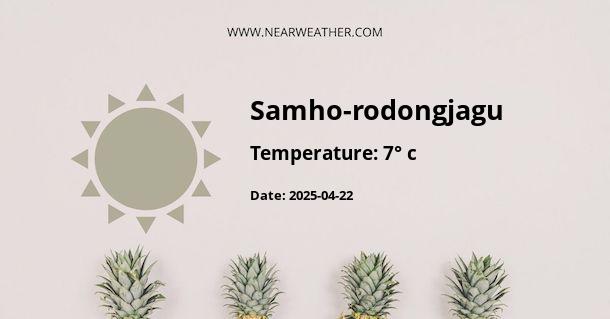Climate and Weather in Samho-rodongjagu, North Korea
Samho-rodongjagu is located in North Korea, a country with a diverse range of climates due to its varied topography and geographical location. Situated in the southern part of the country, Samho-rodongjagu experiences a continental climate with distinct seasons throughout the year. Let's explore the weather patterns and climatic characteristics of this region.
Temperature
The temperature in Samho-rodongjagu varies significantly between seasons. Summers are warm and humid, while winters are cold and dry. The average summer temperatures range from 25°C to 30°C (77°F to 86°F), with occasional heatwaves pushing the mercury even higher. Winter temperatures can drop to as low as -10°C to -15°C (14°F to 5°F), and occasionally even lower.
The spring and autumn seasons in Samho-rodongjagu are relatively mild and pleasant. During these transitional seasons, temperatures range from 10°C to 20°C (50°F to 68°F), creating comfortable weather conditions for outdoor activities.
Precipitation
Samho-rodongjagu receives a moderate amount of rainfall throughout the year. The region experiences a monsoon-influenced climate, with distinct wet and dry seasons. The wettest months are from June to August, with July being the rainiest month. During this time, the region receives an average of 150 to 200 mm (6 to 8 inches) of rainfall per month. The summer rainfall is essential for agriculture and helps to maintain the lush green landscapes of the region.
On the other hand, the dry season extends from November to April, with February being the driest month. During these months, the average monthly rainfall drops to around 20 to 30 mm (0.8 to 1.2 inches). The dry season is characterized by clear skies and low humidity, making it an ideal time to explore the region.
Snowfall
Samho-rodongjagu experiences significant snowfall during the winter months. The region is known for its beautiful winter landscapes covered in a thick blanket of snow. Snowfall usually begins in late November or early December and continues until February. The average snowfall in Samho-rodongjagu ranges from 20 to 30 cm (8 to 12 inches) per month during the peak winter months. The snow-capped mountains and frozen lakes create a picturesque scenery that attracts tourists from around the country.
Wind
The prevailing winds in Samho-rodongjagu are influenced by the topography and the surrounding mountain ranges. The region experiences moderate to strong winds throughout the year, with the strongest winds occurring during the winter months. These winds, known as the Siberian winds, blow from the northwest and bring cold air from the Siberian region, causing a drop in temperatures.
Extreme Weather Events
Samho-rodongjagu, like other regions in North Korea, is prone to extreme weather events such as typhoons and heavy rainstorms. Typhoon season typically occurs from June to September, with the peak activity in August. These powerful storms can bring strong winds, heavy rain, and flooding, causing significant damage to infrastructure and agriculture.
Conclusion
Samho-rodongjagu experiences a continental climate with distinct seasons. Summers are warm and humid, while winters are cold and dry with significant snowfall. Spring and autumn offer milder temperatures, and the region receives a moderate amount of rainfall throughout the year. It is important to keep in mind the potential for extreme weather events, such as typhoons, during certain times of the year. Whether you are visiting Samho-rodongjagu for its winter landscapes or exploring its lush green scenery in the summer, the region offers a unique climate experience throughout the year.
A - Samho-rodongjagu's Latitude is 39.947498 & Longitude is 127.871109.
A - Weather in Samho-rodongjagu is 7° today.
A - Climate Conditions in Samho-rodongjagu shows overcast clouds today.
A - Humidity in Samho-rodongjagu is 95% today.
A - Wind speed in Samho-rodongjagu is 9.47 km/h, flowing at 200° wind direction. today.
